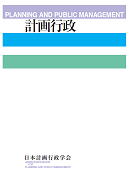Volume 39, Issue 4
Displaying 1-13 of 13 articles from this issue
- |<
- <
- 1
- >
- >|
Open Date Policy and Creating Public Values
Introductory Remark
-
2016Volume 39Issue 4 Pages 1-2
Published: December 15, 2016
Released on J-STAGE: June 03, 2022
Download PDF (524K)
Special Articles
-
2016Volume 39Issue 4 Pages 3-8
Published: December 15, 2016
Released on J-STAGE: June 03, 2022
Download PDF (894K) -
2016Volume 39Issue 4 Pages 9-14
Published: December 15, 2016
Released on J-STAGE: June 03, 2022
Download PDF (734K) -
2016Volume 39Issue 4 Pages 15-20
Published: December 15, 2016
Released on J-STAGE: June 03, 2022
Download PDF (1241K) -
2016Volume 39Issue 4 Pages 21-26
Published: December 15, 2016
Released on J-STAGE: June 03, 2022
Download PDF (847K) -
2016Volume 39Issue 4 Pages 27-32
Published: December 15, 2016
Released on J-STAGE: June 03, 2022
Download PDF (4239K)
Research Paper
-
2016Volume 39Issue 4 Pages 33-44
Published: December 15, 2016
Released on J-STAGE: June 03, 2022
Download PDF (2667K) -
2016Volume 39Issue 4 Pages 45-52
Published: December 15, 2016
Released on J-STAGE: June 03, 2022
Download PDF (2635K) -
2016Volume 39Issue 4 Pages 53-60
Published: December 15, 2016
Released on J-STAGE: June 03, 2022
Download PDF (2322K) -
2016Volume 39Issue 4 Pages 61-67
Published: December 15, 2016
Released on J-STAGE: June 03, 2022
Download PDF (2049K)
Local and Regional Planning
-
2016Volume 39Issue 4 Pages 68-71
Published: December 15, 2016
Released on J-STAGE: June 03, 2022
Download PDF (2277K)
Book Review
-
2016Volume 39Issue 4 Pages 72
Published: December 15, 2016
Released on J-STAGE: June 03, 2022
Download PDF (554K) -
2016Volume 39Issue 4 Pages 73
Published: December 15, 2016
Released on J-STAGE: June 03, 2022
Download PDF (539K)
- |<
- <
- 1
- >
- >|
